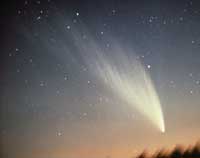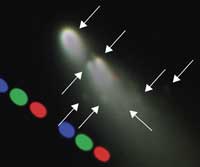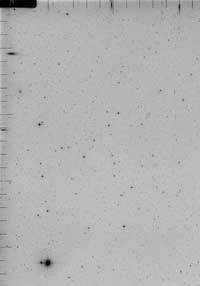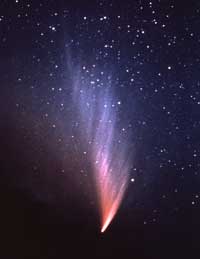The joy of discovery: a personal experience Understand article
Richard West describes the excitement and joy of discovering a new comet.

Image courtesy of Peter
Stättmayer ©
Yesterday, in front of the computer at home, I had a funny feeling of déjà vu. The photo on the website of the European Organisation for Astronomical Research in the Southern Hemisphere (ESO)w1 somehow looked familiar. The comet seemed a bit unsharp, and there were several diffuse blobs. Clearly, Comet Schwassmann-Wachmann 3w2 was in the process of breaking up (see image below). After the comet’s numerous approaches to the Sun in its elongated orbit, the intense solar radiation was finally taking its toll. This cosmic iceberg full of dust – the comet’s ‘nucleus’, as we astronomers call it – was falling apart, producing a swarm of baby comets.
Almost exactly 30 years ago, in March 1976, I had seen this happen to another comet. Looking through one of the largest telescopes at ESO’s La Silla observatory on a remote mountain in the Chilean Atacama desert, I had witnessed the awesome demise of one of the brightest comets of the 20th century, marvelling at the forces of nature in action. Once more, my thoughts went back further to an exhilarating afternoon in November 1975. I remember it as if it were yesterday. What a lucky day in my life!

disintegrating Comet
Schwassmann-Wachmann
3 and associated
mini-comets (arrows)
Image courtesy of ESO
But wait, I must tell the story from the beginning. It started much earlier, in the early 1960s, when astronomers from several countries decided to unite their efforts and set up what was to become Europe’s astronomy organisation, ESO. One of its most important tasks was to survey the relatively little-known southern sky, mapping hundreds of millions of heavenly objects south of the celestial equator. Such a programme would find many hitherto unknown stars, planets, nebulae and galaxies, opening wonderful opportunities for subsequent detailed studies and leading to an astrophysical bonanza.
My own country, Denmark, joined ESO in 1967. At that time, I worked at the Copenhagen University Astronomical Observatory. Two years later, I was fortunate to obtain a position at ESO, as Assistant Astronomer to the Director General, Professor Adriaan Blaauw. In 1972, I was charged with setting up the new ESO Sky Atlas Laboratory on the premises of CERNw3 in Geneva, Switzerland, as part of a collaboration between the sister organisations.
The laboratory’s main task was the production of ESO’s Atlas of the Southern Sky, consisting of faithful reproductions of 30 x 30 cm photographic glass plates exposed with a giant camera (a 1 m Schmidt telescope), optimised to survey large sky areas. For this, I worked closely with the German astronomer Hans-Emil Schuster and his night assistants, the brothers Guido and Oscar Pizarro from Chile, who did the original exposures at La Silla, as well as with the laboratory staff, including Bernard Dumoulin, Françoise Patard, Bernard Pillet and Jean Quebatte.

plate on which the trail of
Comet West was first seen.
Can you find the fuzzy comet
trail? Stars and galaxies
appear as black dots; the
brighter ones have different
forms that are artefacts of
light reflection in the
telescope. (See here for the
answer)
Image courtesy of ESO
The real work started in 1974, when a steady stream of exposed glass plates arrived in Geneva, carefully packed in big containers to survive the hardships of the long journey from Chile. It was one of my jobs to check all these plates, judging their quality, e.g. in terms of image sharpness and limiting magnitude (a measure of the faintest stars visible on the plate). Only the very best plates, with the sharpest images and the faintest objects, were then included in the Atlas and several hundred photographic copies were made and delivered to other observatories all over the world.
On these negative plates, images of stars and galaxies appeared as small clusters of silver grains in the photographic emulsion. I normally started out with a quick ‘eye scan’ – being rather short-sighted, I could see even quite small details on the plates. Then followed a careful evaluation under a microscope, examining even the faintest smudges. The scrutiny of each plate normally took between five and 15 minutes.
Each plate contained images of several million stars in the Milky Way and thousands of galaxies. Depending on the position in the sky, there were also nebulae of gas and dust, or short trails of asteroids in the Solar System which had moved in their orbits during the exposure. It was a strenuous but fascinating job. The photos showed innumerable celestial objects that had never before been seen by human eye – what a privilege! Many of them were later catalogued systematically from the Atlas copies by diligent colleagues in various countries.
Little did I know, on the morning of 5 November 1975, what would happen later that day. It must have been about two o’clock in the afternoon when I cautiously removed a newly arrived plate from its white cover, took off my heavy glasses and made a first quick scan, supporting the plate edges with my hands a few centimetres in front of my eyes.
At one edge, I came upon a little black smudge that looked somehow strange. Yes, it was like the trail of a minor planet, but it was fuzzy, as the trails of planets are not. And it looked fuzzier on one side than the other! Could it possible be…? A quick glance through the microscope confirmed my suspicion – it was indeed the image of a moving object. Oh yes, it was undoubtedly that of a comet with a short tail, and thus most likely located in the inner Solar System.
In the 1970s, only two dozen comets were being discovered each year. This was becoming exciting! Questions arose: where was this comet in space? Was it perhaps already known? A quick check in the tables did not obviously identify it as any known comet. Which way was this comet moving – east or west? You cannot tell this from one trail alone, but suppose I could find another trail on another plate taken before or after this one! Then the direction would become known. And if I found three trails, it would become possible to calculate the orbit and predict the comet’s future motion….!
This plate was taken by Guido Pizarro on 24 September 1975, so I searched some other plates obtained a month earlier. One hour passed: nothing found. But then, incredibly, there it was: another, much fainter, trail right in the corner of a plate taken by Oscar Pizarro on 10 August. And another one on a plate from 13 August! I could hardly believe my luck. Lost to the world, I went to the large measuring machine to determine the exact sky positions of the three trails; this took me another hour.
The rest is recorded history. We telexed (no emails in those days!) the data to Brian Marsden at the Central Bureau of the International Astronomical Union (IAU) in Baltimore (Maryland, USA). I went home that evening and tried to relax with my family, but those trails were in my head all the time. Brian’s telex answer came the next day. The three trails were of the same comet, it was hitherto unknown, and Brian was able to calculate the orbit! He issued IAU Circular 2860 the same day, and under the heading “COMET WEST (1975n)”, he stated that “the orbit indicates that the comet should be conveniently placed for observation in the northern hemisphere in the morning sky at m1 ~ 5 in mid-March 1976”. Magnitude five! That meant that this comet might become visible to the naked eye! I had in fact discovered a relatively rare object.
As the comet moved nearer to the Sun, it continued to brighten, as predicted. However, in mid-February 1976, it quite unexpectedly brightened more than 15 times within a few days. It then disappeared behind the Sun as seen from the Earth and when it re-appeared in late February, it had become very bright. Indeed, several observers were able to see the comet’s ‘head’ (the gas and dust cloud surrounding the nucleus) in broad daylight. One wrote: “brilliant like the planet Venus”.

Comet West in the morning
sky, obtained in early March
1976
Image courtesy of Peter
Stättmayer ©
Early in the morning of 1 March, I woke my 7-year-old son. Leaving sleeping Geneva behind us, we ascended nearby Mount Salève and found a site with a view towards the eastern horizon. Dawn was approaching and the colour of the clear sky above the grandiose alpine mountains slowly changed from black to dark blue to red. Anxiously waiting, we strained our eyes and soon noticed a bright spot rising behind the mountains, almost like a distant lighthouse. It was deeply touching to show my son the comet I had seen on that plate four months earlier.
During the next few days, it moved further away from the Sun and rose earlier, now with a long and majestic tail in a darker sky. I got a call from my parents. Living north of Copenhagen, they went to the Øresund beach in the early morning and saw the comet rising just south of the island of Hven (Ven), the site of the observatory of Tycho Brahe (1546-1601), one of the most famous astronomers before the invention of the telescope changed astronomy forever.
The comet was observed intensively over this period. Thanks to its unusual brightness, detailed investigations could be made of its composition and the impressive structures in its coloured tails. It broke up, right in front of the astronomers, with an intense release of fresh cometary material. Enormous amounts of glowing gas and reflected sunlight produced a spectacular sight for professionals and amateurs alike, as well as for many stalwart, early risers among the public. Marvellous photos were taken, some by teachers and their school classes.
Comets are named by the International Astronomical Unionw4 after the discoverer(s). For me, to have a celestial body – ‘Comet West’ – named after me was a very great honour and a wonderful feeling!
This is a personal story which illustrates an important phenomenon in real science: the joy of making a discovery. I have been fortunate to experience this fantastic feeling in my career as an astronomer, certainly that afternoon in Geneva, and sometimes at night in front of the computer screen on mountain observatories. Such moments are priceless. Of course, scientists study science to gain new insights and make them known to the world, contributing to our common knowledge. However, I think that many will agree that it is not only the final results, but also many facets of the process itself – and especially some rare and intense moments on the road towards understanding – which constitute the true highlights of the scientific profession.
Web References
- w1 – For more information about the European Organisation for Astronomical Research in the Southern Hemisphere (ESO).
- w2 – The ESO press release about Comet Schwassmann-Wachmann 3.
- w3 – CERN is the world’s largest particle physics laboratory.
- w4 – The International Astronomical Union aims to promote and safeguard the science of astronomy in all its aspects through international co-operation
Resources
- Further reading about Comet West is available on Gary Kronk’s Cometography.
- More details of Comet West are also available from Wikipedia.
- IAU Circular 2860 announcing the discovery is available here: http://cfa-www.harvard.edu/iauc/02800/02860.html (more information about theomet can be seen on Circulars 2910, 2919, 2924, 2927, and 2928).
- Comet West became a ‘great comet’ and was technically the brightest – if only for a very short time – in the 20th century. Background information on great comets is available from:





